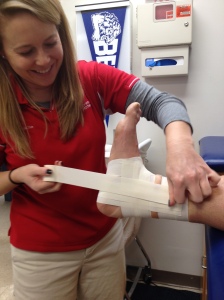The Effectiveness of Ankle Taping
February 22, 2014 6 Comments
To tape or not to tape, that is the question.
And the answer is of interest to a lot of folks out there.
“Residual Mechanical Effectiveness of External Ankle Tape Before and After Competitive Professional Soccer Performance,” published in our January issue, has been our most emailed study so far this year. On our twitter feed, @csjmonline, I can also tell you that the posts I’ve been making have been getting a lot of traffic.
There is a great deal of interest in this most utilitarian of subjects. It’s original research coming from a group out of Germany: Best, Mauch, Böhle et al., and currently on the CJSM website it’s FREE! It’s time to check it out!
All of us in clinical sports medicine can attest to the ubiquity of ankle injuries. The authors of this study note, for instance, that aside from muscle strains, ankle ‘distortions” are the most frequent injuries seen in professional soccer, accounting for about 20% of all injuries. They further note that bracing and adhesive taping of the ankle are commonly used to prevent and treat these injuries, though “….the effect of adhesive ankle tape remains inconclusive, in comparison to semirigid orthoses and braces….”
There is considerable debate over the residual effectiveness of taping over the course of a prolonged sporting session. The issue is of practical significance, as the author’s note that during soccer matches, a disproportionately high number of injuries occur during the last third of each halftime. To date, there have been few studies that have evaluated the mechanical, protective properties of tape beyond 30 minutes of exercise.
It is in this context, then, that the authors’ developed what amounts to their research hypothesis: “…during realistic competitive soccer performance reflecting a halftime of 45 minutes–ankle tape might lose most of its assumed initial mechanical effectiveness to reliably prevent ankle distortions.” They set out to test just that.
Among the many aspects of this study I enjoyed was the simplicity of the research design. The authors recruited 17 professional male premier league football players and tested them in dry, temperate conditions outdoors. After tape application, the study participants underwent 45 minutes of soccer training designed to “…imitate a match situation as closely as possible.”
All participants had ankle inversion range of motion (ROM) tested at ‘baseline’ (before taping); immediately post taping (‘pretest’); after 45 minutes of simulated match play (‘posttest’); and a final retest without tape (‘baseline retest’).
An aspect of this study I found notable was the extensive Methods section. The simplicity of design allows the authors to report their results concisely. But, in a study like this, the ‘devil is in the details’ regarding how those results were obtained. The authors very methodically describe the passive ankle inversion device they used to measure ankle ROM; the tape application method; and the training and exercise environmental conditions. Two and a half pages and several figures will help any lab out there which wants to replicate this study.
And so, the results. The most notable one: ankle inversion ROM in a taped ankle increased after 45 minutes of soccer from 7 degrees to 12.6 degrees, a figure which reflects 90.3% of the inversion ROM in an untaped ankle. In other words, after 45 minutes of soccer match play, the ‘residual mechanical effectiveness’ of a professionally applied ankle taping job is minimal. In the authors’ words: ” The initial significant protection of external ankle-tape support declines almost completely without relevant remaining residual mechanical effect after 45 minutes…”
One of the strengths of this study was the simulation of a soccer halftime, as most of the studies of similar design in the literature have assessed residual mechanical effectiveness over much briefer periods of time, or in tasks which are not functionally equivalent to soccer match play.
Overall, the study contributes greatly to the evidence-based discussion regarding ankle taping. I strongly commend it to you.
To tape or not to tape: what’s your answer to that question? Read the study, and let us know!


Tape? Fuhget about it! Ankle braces are the scientifically proven way to prevent ankle injuries:
http://www.ncbi.nlm.nih.gov/pubmed/19586798
Tape sucks because it weakens over time, as these study confirms. Ankle braces OTOH are definitely the way to fly: http://www.ncbi.nlm.nih.gov/pubmed/19586798
Pingback: I’ll just leave this here for some discussion… | Developing A New Athletic Trainer
I don’t believe that this systematic review shows that bracing is superior to taping. In fact the conclusion is that they are both equally effective at decreasing ankle sprains. Ricard et al. felt that though tape does loosen during exercise, ankle taping still provides residual restriction. Thus, the loosening of the support method may not necessarily eliminate its protective effect. The results of this systematic review support this conclusion
Bracing is much more economical and is easier to apply without the help of and athletic trainer. If the brace loosens it is very easy to tighten the brace. Some athletes though, such as dancers and gymnasts, may be more likely to tape due to aesthetic reason.
mitch, i think you are referring to the systematic review mentioned by some of the commenters, as the post itself and CJSM study itself are purely one which relate to the residual mechanical effectiveness of taping. so, here’s the link to the systematic review which i know you are aware of but followers of this comment thread want as a reference to understanding your commentary http://www.ncbi.nlm.nih.gov/pubmed/19586798 thanks for your comments.
Any thoughts about the use of cloth wraps (secured with an outer layer of tape)? This technique was taught to me as a college athlete by an Olympic trainer (cerca 1980). The wrapping includes two “ankle locks” in opposite directions. Anecdotally, I like the way it feels and still wrap ankles for long hikes in the mountains.